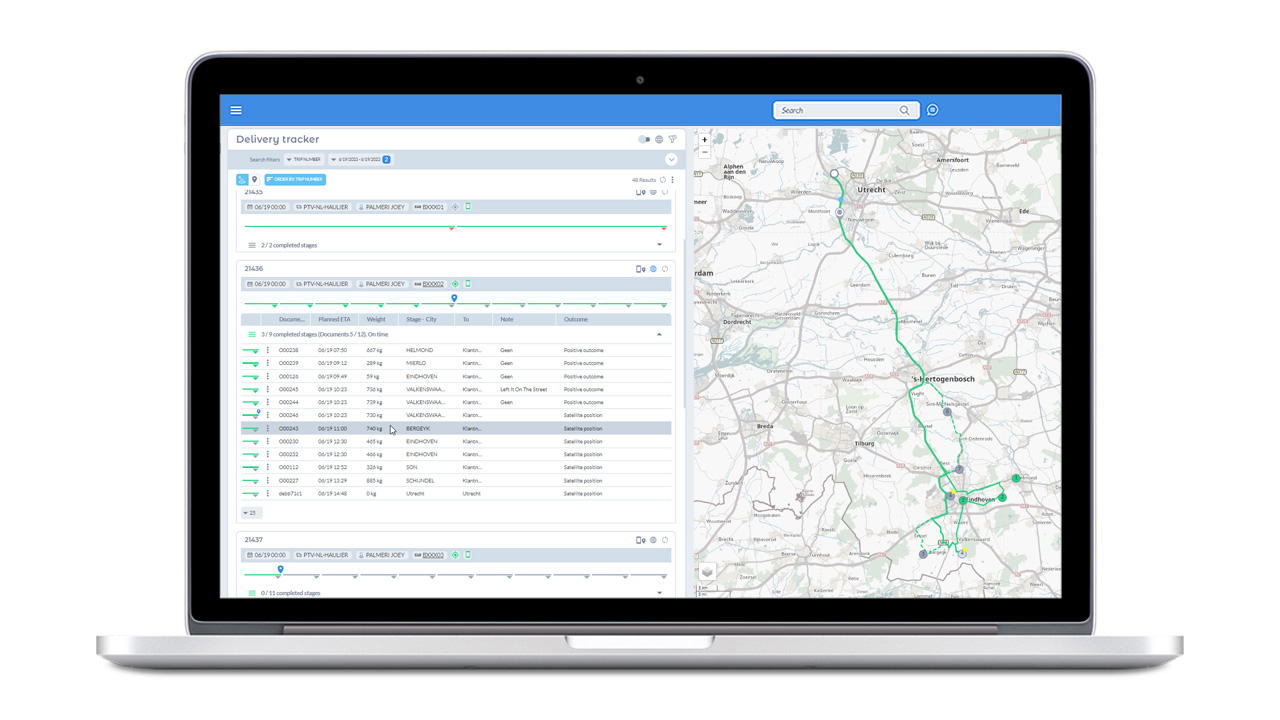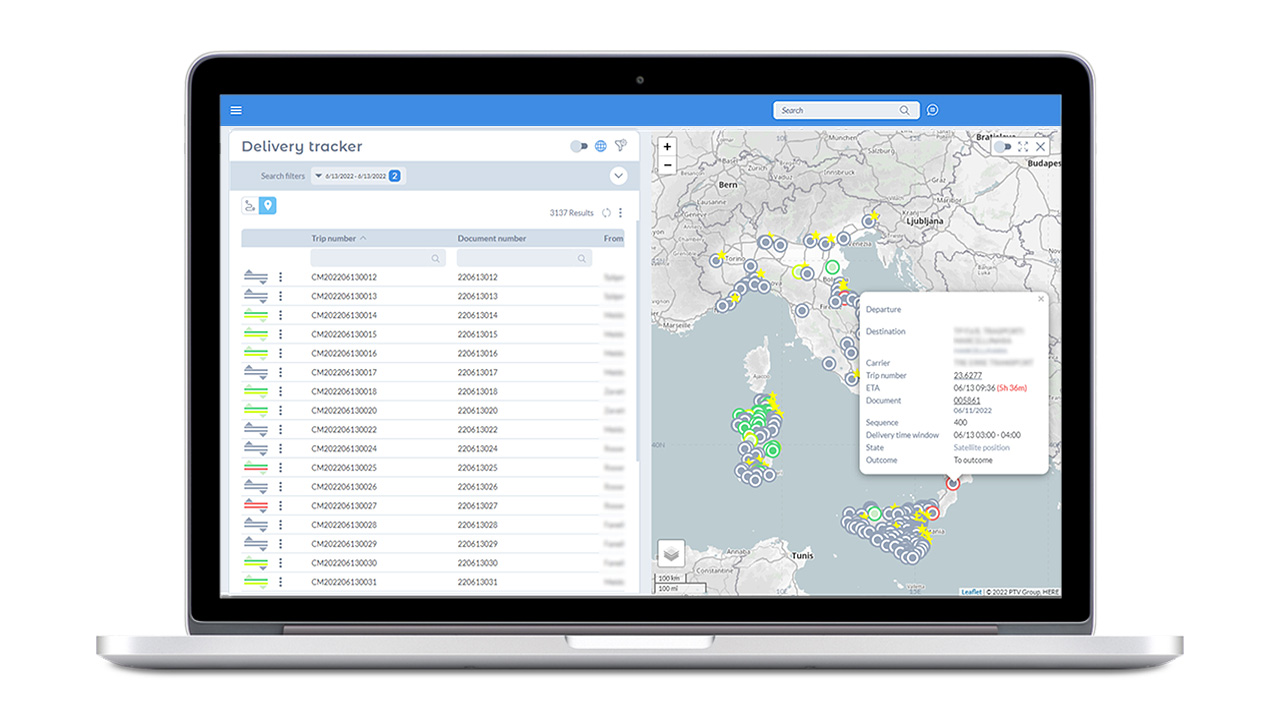The Ultimate Guide to Real-Time Transport Visibility
As customers increasingly demand faster delivery times, the challenge the industry faces is to deliver a reliable and high-quality service despite uncertainty. To do this though, full visibility of freight at all times is required.
That’s where real-time transport visibility software comes in. Not only can it help you track and manage shipments in real-time, but it also gathers data from each delivery which, when analysed, can bring you a whole host of benefits beyond simply getting a package to the right place at the right time.
We explain everything you need to know about transportation visibility and how it can help improve your transport & delivery operations.
What is transport visibility?
The transport visibility platform puts you back in control of your transport operation
This starts with insight into the status of all orders, routes, and vehicles. The transport visibility platform receives the necessary data directly from various data sources:
- From the mobile app that is integrated with the control tower
- From the telematics systems of your own and other people’s trucks
- From the transport management systems of freight forwarders and carriers
- From other business applications or real-time transport visibility platforms

What are the benefits of improved transport visibility?
Improve planning
Real-time monitoring enables planners to both modify live routes when necessary, and to also improve future route planning. Transport visibility can help anticipate problems ahead of time by identifying where delays might occur, for example because of heavy traffic, and enable planners to proactively manage them. This is particularly important for time-sensitive deliveries.
Transport visibility technology also enables data about each delivery to be collected and fed back into future route planning. By identifying recurring anomalies or delays, new routes can be planned to eliminate these disruptions. The data can also be used to create more accurate time windows, ensuring more efficient routes can be created that maximise the available time.
Increase efficiency and lower costs
Real-time tracking can help to reduce unexpected costs resulting from delays – such as demurrage or detention fees – by helping to pre-empt factors that might trigger them.
The use of tools such as ePOD within transport visibility technology enables companies to move from manual processes for recording deliveries, to automated ones. This not only speeds up operational tasks, such as issuing invoices or managing complaints, but also removes time-intensive data entry tasks from staff so that they can focus on more strategic jobs.
Deliver better customer service
The ability to pre-empt and avoid disruptions means fewer delays for customers. And by using historical delivery data to inform future planning, faster deliveries can be achieved over time.
Giving real-time visibility to customers around their deliveries can help them to improve their own operations. Not only can they plan to receive shipments based on more precise predicted ETAs, but they can also reduce any potential impact on their business in case of delays. This increases transparency and improves customer trust and loyalty. Define workflows to send personalized notifications & alerts in real-time and detect anomalies in the order fulfilment process.
Improve collaboration and data sharing
To have complete transport visibility, it requires data sharing between all stakeholders – from supplier to driver – so that each stage of the delivery can be tracked. By sharing information in real-time through GPS location or digital documentation, it means that more accurate data can be collected, analysed and used to improve processes in future.
Tools for real-time communication make collaboration and data sharing easier. Collaborate and share information with customers, consignees, carriers & subcontractorts within one platform.
Reduce CO2 emissions
The data and insights that are gathered because of better transport visibility can be used to improve the environmental impact of transport operations. Planned and actual routes can be compared, and historical delivery data can be fed into route optimisation tools to improve fuel efficiency in future transport execution.
Want to learn more about how our transport visibility software can help your business?
How does transport visibility software work?


Live data collection
Transport visibility is usually managed via a transport control tower (TCT). This is a centralised method of collecting, managing and analysing data that can then be used to make more strategic operational decisions.
Real-time data can be collected from several sources, including an integrated mobile app, a truck’s onboard telematics systems, transport management systems from different stakeholders, and other business applications with visibility of operations.

Accurate ETA calculation
Real-time visibility platformscombine live data to track the location of vehicles and goods at any given time. AI and machine learning (ML) can then be used to calculate more accurate ETAs using the different data points provided. The information gathered can also feed into rerouting decisions in case of delays or disruptions.
Automated processes
Transport visibility technology also helps you to automate processes and improve efficiencies in your operations. For example, by sharing documentation with all stakeholders digitally. This reduces the chances of errors or lost paperwork and speeds up the overall delivery process. Tools, such as ePOD, also streamline the process of receiving a package for the consignee.
Once the delivery is completed, all associated documentation can be automatically uploaded to your central database. The data can be processed in real-time and then fed into your other systems to help with strategic decision making.
What can you do with transport visibility software?
Our software provides the unique and central SaaS platform of system connectivity and information exchange along the entire transport network and its different stakeholders.

FAQs about transport visibility
What is a transport visibility solution?
A transport visibility solution is a software platform that provides real-time tracking and monitoring of shipments and vehicles in the logistics and transport industry. It enables businesses to have a clear view of their goods in transit and make informed decisions.
How does a transport visibility solution work?
Transport visibility software utilise GPS, IoT devices, and data analytics to collect and transmit real-time information about the location, status, and condition of shipments and vehicles. Users can access this information through a user-friendly interface.
What are the benefits of using a transport visibility solution?
Some key benefits include improved supply chain visibility, better inventory management, reduced operational costs, enhanced customer service, and the ability to respond quickly to disruptions in the transport network.
Can I integrate a transport visibility solution with my existing logistics software?
Yes, enhance your logistics operations by seamlessly integrating route optimization and real-time transport visibility through our connected solutions. Or with other logistics software, such as TMS (Transportation Management Systems) or WMS (Warehouse Management Systems).
Is real-time tracking the only feature of a transport visibility solution?
No, while real-time tracking is a significant feature, these solutions often include additional capabilities like predictive analytics, alert notifications, ePOD, communication, collaboration, and reporting tools to optimize and streamline logistics operations.
Can small and mid-sized businesses benefit from transport visibility software?
Yes, transport visibility solutions are scalable and can be adapted to the needs and budgets of businesses of all sizes. They can offer cost-effective ways to improve efficiency and visibility in logistics operations.
How quickly can I expect to see a return on investment (ROI) after implementing a transport visibility solution?
ROI timelines can vary depending on the specific business and its goals, but many companies experience significant ROI within a few months of implementing a transport visibility solution due to improved efficiency and cost savings.